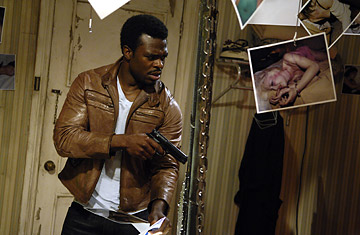
Lyriq Bent in a scene from Saw IV.
Saw IV: Unrated Director's Cut
2007; Director: Darren Lynn Bousman; Writers: Patrick Melton, Marcus Dunstan, Thomas Fenton
With Tobin Bell, Lyriq Bent, Costas Mandylor, Scott Patterson, Betsy Russell
Lionsgate
Available Jan. 22, List Price $29.95
A coroner is stooped over a corpse, peeling away the scalp, removing the brain, slicing the chest to get to the heart. Even with movies and prime-time TV a veritable blood-sluice of autopsies, this is one of the more noxious, a kind of CSI: Miasma. But the first three Saw films revealed "Jigsaw" John Kramer (Bell) as a mad master of torture; it's only appropriate that his evisceration should be lovingly detailed in the fourth. Inside Jigsaw's stomach the coroner finds a tiny tape recorder, with a message for his latest accomplice-victim: "You think it's over just because I am dead. It's not over. The games have just begun."
The most creative work in a Saw movie is in researching the legend of Tomas de Torquemada and the literature of the Marquis de Sade, then adapting their grotesquiest punishments to modern use. At times the writers have to rely on their own imaginations of dismemberment. This time, a blind man (eyes sewn together) and a mute man (lips sewn together) must communicate so that one, tops, can stay alive. A woman is strapped to a chair, her hair attached to pulleys that tighten till her scalp is nearly removed. A morbidly obese man clamped to a bed must stab his eyes out to survive; oops, too late, three of his limbs are yanked off. Meanwhile, one of the investigating cops is found murdered ("Somebody get the rats off her," a colleague says). And, in a warehouse chamber, two men are slowly undergoing Jigsaw's shock therapy: one man standing on a block of ice, another suspended over water that will electrocute him when the ice melts.
But the most exquisite form of torture is the writers' squeezing out one more Saw movie, with threats of more to come, under the handicap of having had their main character and controlling demon killed off in the last episode. They keep the franchise alive, or at least undead, by exercising two tiny bits of ingenuity: they have the main action of the film run concurrently with that of Saw III; and they provide copious flashbacks of Kramer's earlier years to demonstrate what turned a man of dour charity into a monster of vengeance. Saw IV ain't exactly Godfather II, but it does move forward and backward like the Coppola-Puzo film to fill out the saga of its John Goreleone. The tactic also gives its star as much screen time as he got in the first two Saws combined.
In quality, then, if you care, Saw IV is a little better than II, way above the narratively exhausted III and pretty far below the original film, which really was original. It allows Jigsaw to elucidate his raison d'eathtre, when he tells his very first victim: "Good doesn't lead to good. nor bad to bad. People steal, don't get caught, live the good life. Others lie, cheat and get elected." (OK, let's slaughter all the white-collar thieves and politicians.) "Feel what I feel," he croaks to his victims."Save as I save." He wants people to face their demons — his actually — and make life-or-death choices. You're human, so you must play God. It's bilge, since life is less likely to force these draconian choices on us than to dangle the carrot of moral and career compromise. But unlike Untraceable, now in movie theaters, the Saw series at least has a lunatic coherence of its theme and its torture effects.
The extras include a video diary from director Bousman (rhymes with Houseman, if you were wondering). While he's shooing the fat man disarming (and dis-legging) scene, his parents drop by; when it's over the three pose for a photo, dad and Darren holding fake severed limbs. There are also the usual extended how-to's on the assemblage and execution of the torture devices. Lionsgate has no qualms showing these D.I.Y. tips for budding sociopaths, but whenever Bousman wears a T shirt that bears a commercial logo, it's digitally blurred out. Suddenly everyone is very fastidious.